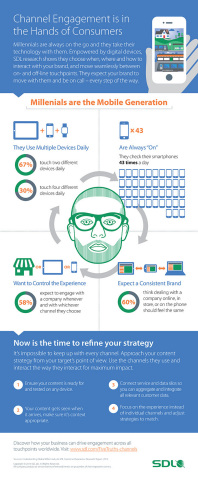WAKEFIELD, Mass.--(BUSINESS WIRE)--Today, SDL (LSE: SDL) released the final report of the “Five Truths for Future Marketers” series titled “Channels are Irrelevant,” that features results from SDL’s global survey of more than 1,800 millennials (ages 18-36). The data reveals that today’s consumers no longer care about where they are or what device they are on when interacting with a brand, as 58 percent of millennials polled said they expect to engage with a company whenever they choose and via whichever channel they elect. The data highlights the critical need for brands to stop focusing on channels and instead apply what they know about their consumers to elevate the overall experience in the buying journey.
Millennials are the “always on” and connected generation, demanding consistent and seamless interaction with brands wherever they are and from any device they choose. According to the data, millennials touch their smartphones 43 times per day and 30 percent admit they touch more than four devices over the course of 24 hours. Even through the myriad of platforms consumers use to interact with a business, 60 percent of millennials surveyed expect a consistent experience from brands whether they interact online, in store or via phone. These statistics indicate how critical it is for marketers to adapt to the rapidly changing range of consumer behaviors, preferences and expectations. Customers move effortlessly between on and offline touch points and they expect brands to travel with them, responding to and anticipating their needs.
“Consumers have drastically changed the way they engage and interact with companies, altering expectations and making it imperative for brands to quickly adapt,” said Paige O’Neill, chief marketing officer at SDL. “To keep pace, marketers should focus on the experiences customers want throughout the customer journey, and adjust company strategies to coincide. If you change the way you engage customers on one channel, it may only be one step in an overall strategy. It is vital for organizations to ensure channels are so connected that they become irrelevant, placing the focus on delivering true omnichannel engagement.”
Millennials are empowered by an overabundance of digital devices and can pick when, where and how they want to interact with brands, making the shift to omnichannel engagement even more daunting. However, if marketers focus on the behaviors, preferences and expectations throughout the customer journey and adjust strategies as needed, customer experience will remain a top priority. For brands, there are three critical questions to guide the process to true omnichannel engagement:
-
Are you tracking where and how customers interact with your brand?
It is essential to meet customers where they are and to consistently offer information they find useful. Content should be specific to each stage of the buying journey and brands must take full advantage of the information and data collected on where their messaging performs well with the buyer. By capturing who is interacting with them and at what stages of the buying journey, brands can deliver relevant information to the consumer, elevating the experience. Growing customer relationships is not always about getting the sale. Marketers need to take a long-term view and understand that meaningful relationships develop over time.
-
Is your customer experience consistent across different devices and
platforms?
Consistent customer experience can be a key differentiator for a brand. It reinforces your identity, and in a marketplace full of competition and noise, it keeps your audience focused on the most important message of all – yours. According to a recent customer experience survey from McKinsey & Company, measuring satisfaction on customer journeys is 30 percent more predictive of overall customer satisfaction than measuring happiness for each individual interaction.
-
How can you continue to connect internal silos to ensure access to
all the critical data you need?
Marketers must work with relevant departments and agencies to create a communications asset inventory and identify all touch points along the customer journey. Are you effectively collecting – and leveraging – data from every step along the way? If not, what more can you do to improve internal collaboration? Staying attentive and periodically updating both your inventory and related processes allows you to prevent emerging channels from creating new data silos.
To learn more about SDL’s “Channels are Irrelevant” Truth, download the whitepaper and infographic. The complete results of the Understanding the Millennials study can be found here.
About SDL
SDL (LSE: SDL) allows companies to optimize their
customers’ experience across the entire buyer journey. Through its web
content management, analytics, social intelligence, campaign management
and translation services, SDL helps organizations leverage data-driven
insights to understand what their customers want, orchestrate relevant
content and communications, and deliver engaging and contextual
experiences across languages, cultures, channels and devices.
SDL has over 1,500 enterprise customers, over 400 partners and a global infrastructure of 70 offices in 38 countries. We also work with 72 of the top 100 brands. For more information, please visit www.sdl.com.




